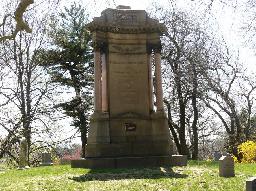Morse, Samuel |
| ARTIST, SCIENTIST (UNITED STATES OF AMERICA) |
|
BORN 27 Apr 1791, Charlestown, Massachusetts - DIED 2 Apr 1872, New York City, New York: 5 West 22nd Street BIRTH NAME Morse, Samuel Finley Breese GRAVE LOCATION New York City, New York: Greenwood Cemetery, Brooklyn (Section 25/32, Lot 57161-69) |
|
Son of the geographer and Calvinist preacher Jedidiah Morse. He went to Yale to study religious philosophy, mathematics and science of horses. He also attended lectures on electricity by B. Silliman and J. Day. During his studies he supported himself with painting. He graduated in 1810. His paintings had caught the eye of the artist Washington Allston, who took him to England to meet the painter Benjamin West. In England he was admitted to the Royal Academy in 1811 and there he painted his "Dying Hercules". In 1815 he returned to America to become a professional painter. In 1816 he painted former President John Adams, in 1817 Judge Woodward and in 1820 President James Monroe. In 1821 he painted the Hall of Congress in Washington D.C. and in 1825 the marquis de Lafayette. In 1819 he had married Lucretia Pickering Walker, but she died in 1825. Then his father died in 1826 and his mother in 1828. Morse left for Europe and he travelled to Italy, Switzerland and France. He painted 38 miniature versions of paintings from the Louvre that he took home to Massachusetts. In 1832, on his way back he met Charles Thomas Jackson, an expert on electromagnetism. After seeing some of Jackson's experiments Morse developed the idea of a single wire telegraph and before the ship reached America he was busy creating his famous telegraph code. In 1836 he tried to become mayor of New York but he received only 1496 votes. In that year in England William Cooke launched a commercial telegraph and Professor Wheatstone did further research on long distance telegraphy, finding a solution for longer distances. They formed a partnership and launched a multiple wire telegraph. From 1837 onwards Morse fully concentrated on the telegraph. He teamed up with Alfred Vail, Professor Leonard Gail and congressmann F.O.J. Smith. With the help of Gail he finally managed to send a message through a longer distance as well but it was not before 1842 that the government supported him. In 1844 a line from Baltimore to Washington was in operation and Morse telegraphed the famous words 'What hath God wrought' from Washington to Baltimore. He received a patent in 1847 and in that same year he bought Locust Grove in Poughkeepsie, New York, now the location of a Morse museum. In 1848 Elizabeth Griswold became his second wife. In 1850 he went to Copenhagen and visited the Thorvaldsen museum with the sculptor's grave. He gave a portrait of Thorvaldsen that he had done in 1830 to King Frederick VII. In 1851 his telegraph became the official standard in Europe (only England still used the Cooke and Wheatstone system). In 1858 he received a large sum of money (400,000 French francs) for the use of his invention in Europe. In the USA received little recognition or money, although his invention was used widely. In 1871 a statue for him was placed in Central Park in New York City. Morse was an anti-Catholic (writing letters to the New York Observer), he defended slavery and he supported the anti-immigration movement of the nineteenth century. |
| Images |
Sources • Samuel Morse - Wikipedia (EN) • Hosting, Connectivity, Security and Office 365 Claranet Soho | |




